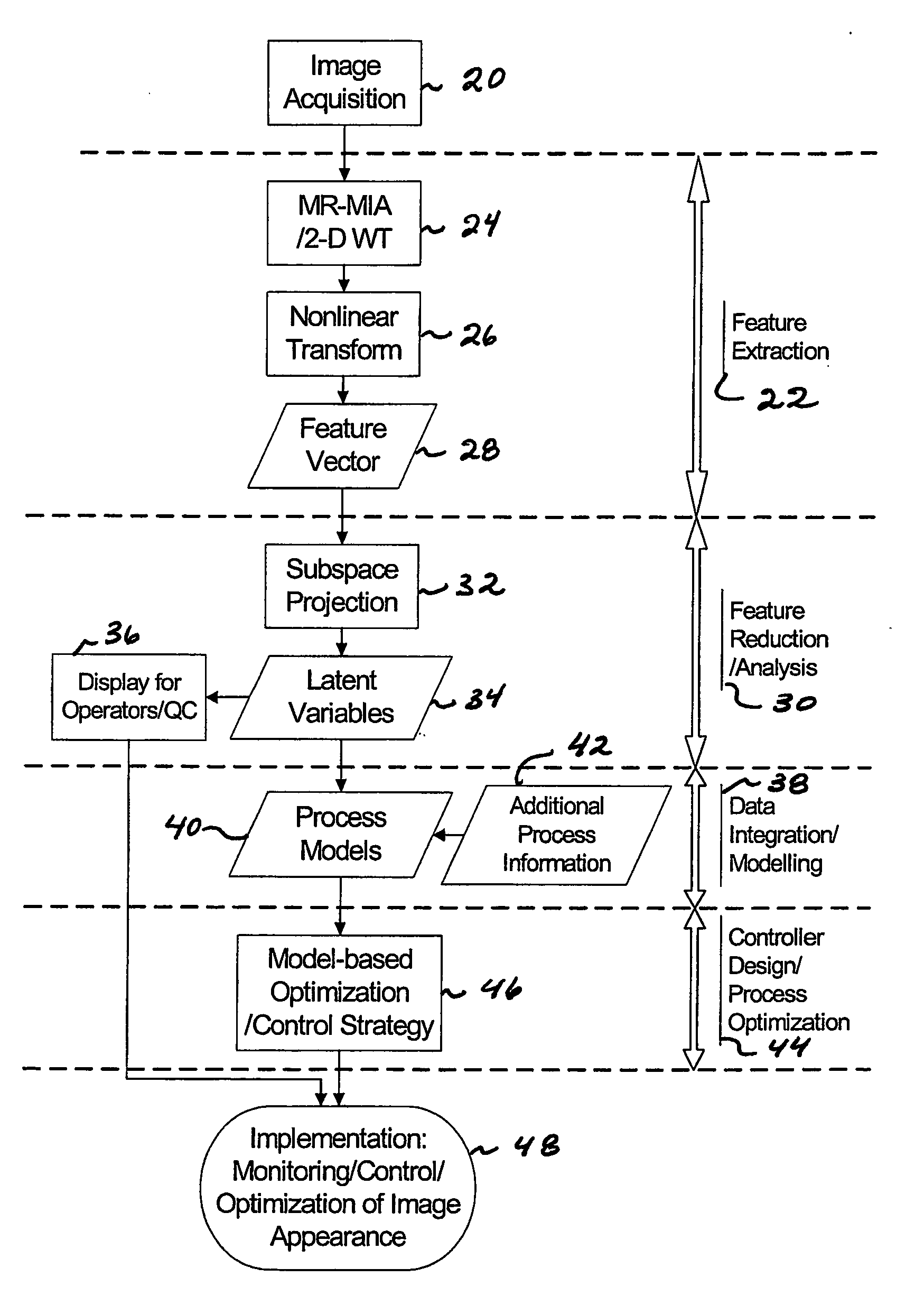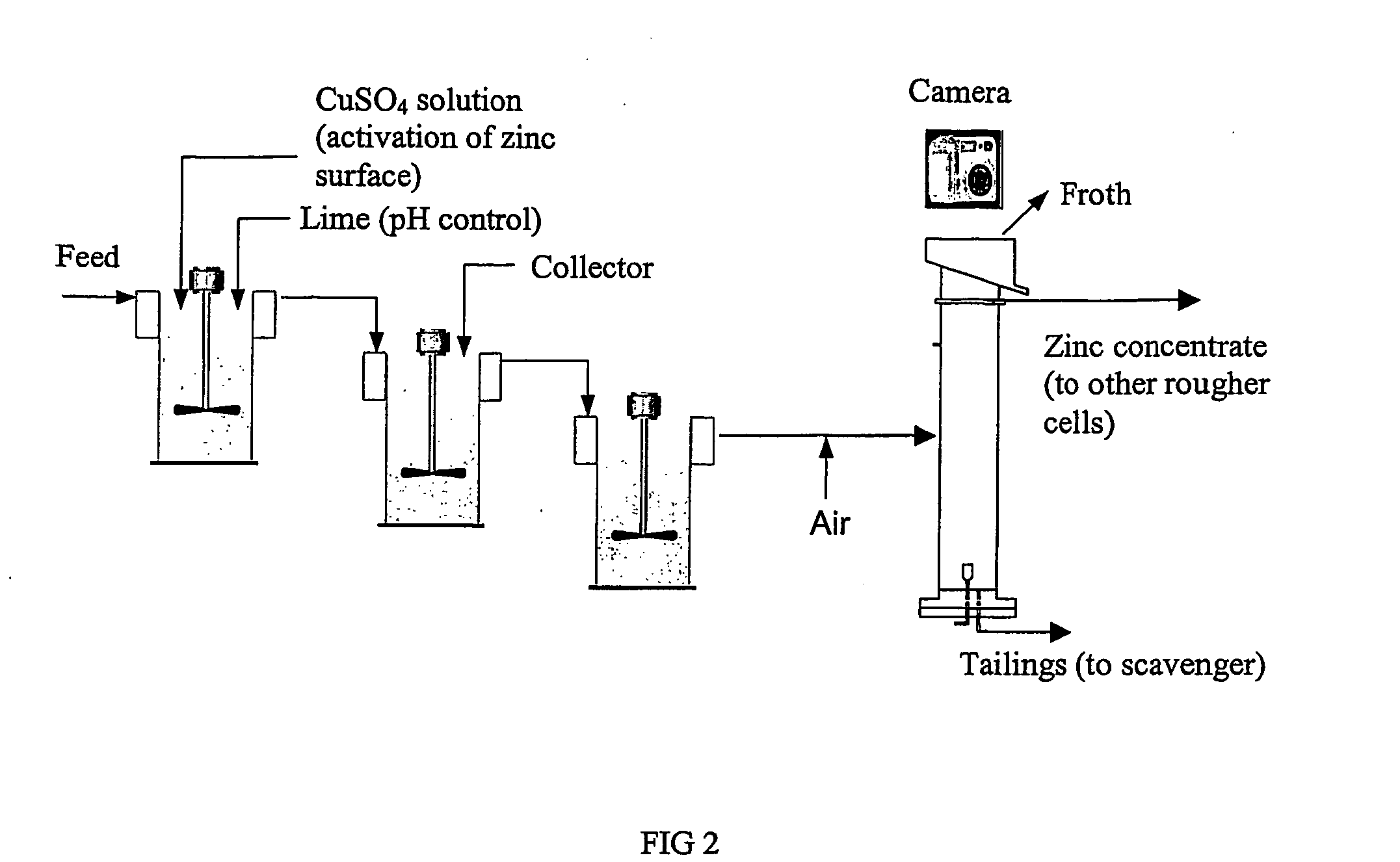Method For Controlling The Appearance Of Products And Process Performance By Image Analysis
- Summary
- Abstract
- Description
- Claims
- Application Information
AI Technical Summary
Benefits of technology
Problems solved by technology
Method used
Image
Examples
example 1
Control of Flotation Froth Appearance / Health in Industrial Mineral Flotation Process
[0075]FIG. 2 is a schematic process diagram of part of Agnico-Eagle's Laronde plant in Quebec, Canada. The camera was installed on top of the flotation column. It samples 24-bit, 720′480 (width′height) color images at every minute. The manipulated variables include pH level, froth level, air flow rate, CuSO4 flow rate, and collector flow rate. Currently, operators change some of these manipulated variables by observing and assessing froth status. Typical froth status described by operators is shown in FIG. 3.
[0076] Image Acquisition 20
[0077] RGB images collected every 30 sec by an automated imaging system.
[0078] Feature Extraction 22
[0079] Features used by the operators for the basis of the assessment are clear windows (see the image in the left above), black holes (see the image in the right above), and bubble size distribution. Using MR-MIA, a wavelet size signature analysis is used to extract i...
example 2
Optimization of Plastic Parts in an Industrial Injection-Molding Process
[0092] Image Acquisition 20
[0093] Grayscale images were collected off-line in a QC laboratory.
[0094] Feature Extraction 22
[0095] After performing a 5 level discrete wavelet transform the standard deviations of the sub-images were calculated as features.
[0096] Feature Reduction / Analysis 30
[0097] Performing a PCA on the feature vectors from the images shows four significant principal components PCs. Based on the t1-t2 score plot in FIG. 7 and the t3-t4 plot in FIG. 8 interpretations of four PCs are as possible; (1) t1 represents presence of any visible patterns in the images, (2) t2 represents presence of structured (horizontal, vertical, and diagonal) wave patterns, (3) t3 represents presence of vertical (positive direction) wave patterns, and (4) images in the negative t4 direction have low intensity and vertical wave patterns.
[0098] Process Modeling / Data Integration 38
[0099] A linear PLS model is built usin...
example 3
Quality Control of Appearance in Manufacture of Artificial Countertops
[0102] Image Acquisition 20
[0103] Color images were collected off-line at the quality control QC laboratory for different products (1) a black and white countertop—discussed below, and a brown, white, grey and black one.
[0104] Feature Extraction 22
[0105] After performing a 5 level discrete wavelet transform (DWT), the energies of each sub-image were calculated as features.
[0106] Feature Reduction / Analysis 30
[0107] Performing a PCA on the feature vectors of the images shows three significant PCs and interpretation of four PCs are as follows; (1) t1 captures fineness (or coarseness) in the images, (2) t2 captures contrast in the images, and (3) t3 captures patterns with more clear edges.
[0108] Currently, pre-determined operating conditions are used for every product grade and final products are imaged and analyzed periodically in the quality control lab. An imaging system in the laboratory would enable monitorin...
PUM
 Login to View More
Login to View More Abstract
Description
Claims
Application Information
 Login to View More
Login to View More - R&D
- Intellectual Property
- Life Sciences
- Materials
- Tech Scout
- Unparalleled Data Quality
- Higher Quality Content
- 60% Fewer Hallucinations
Browse by: Latest US Patents, China's latest patents, Technical Efficacy Thesaurus, Application Domain, Technology Topic, Popular Technical Reports.
© 2025 PatSnap. All rights reserved.Legal|Privacy policy|Modern Slavery Act Transparency Statement|Sitemap|About US| Contact US: help@patsnap.com



